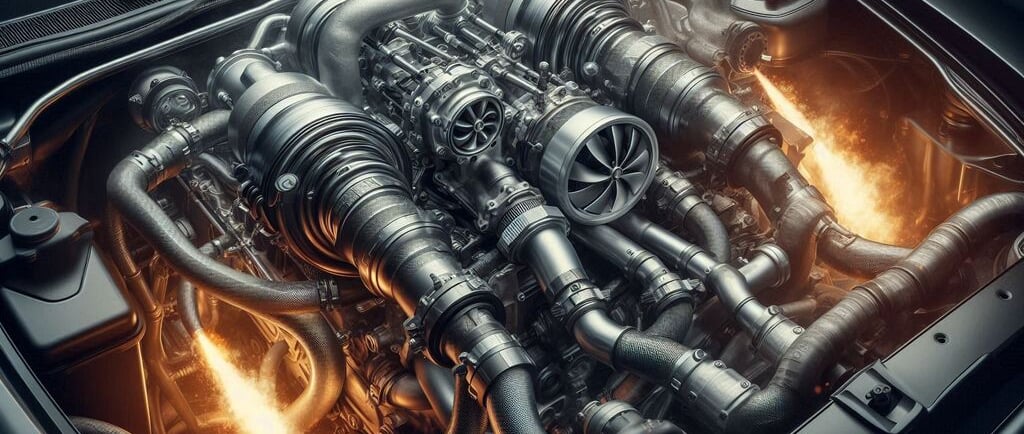Turbochargers and Superchargers
When you hear the word "boost," it likely brings to mind powerful cars speeding down the road.
ENGINE COMPONENTS
11/13/20244 min read


Turbochargers and Superchargers: Which One Boosts Your Engine Performance?
When you hear the word "boost," it likely brings to mind powerful cars speeding down the road. Turbochargers and superchargers are two vital components that help engines achieve that extra power. But what exactly are they, and how do they work? Let’s break down the differences between turbochargers and superchargers, their benefits, and how they can enhance engine performance.
What Are Turbochargers and Superchargers?
Before we get into the details of how these systems work, let’s define them.
Turbochargers: A turbocharger is a device that uses exhaust gases from the engine to spin a turbine, which in turn compresses air and forces it into the engine. This increases the engine's air intake, resulting in more power and efficiency.
Superchargers: A supercharger is a mechanically driven air compressor that forces more air into the engine by using a belt connected to the engine’s crankshaft. This increases the engine's power by delivering more air-fuel mixture into the combustion chamber.
Although both serve to enhance engine performance, they do so in very different ways. Let’s dive deeper into how each one works and their respective benefits.
How Do Turbochargers Work?
Turbochargers are all about efficiency. These systems harness the energy that would otherwise be wasted in the exhaust gases and redirect it to compress fresh air into the engine. The process is relatively simple but highly effective:
Exhaust gases spin the turbine.
The turbine drives a compressor that draws in air.
Compressed air is forced into the engine’s intake system.
Benefits of Turbochargers
Fuel Efficiency: Since a turbo uses exhaust gases, it doesn’t require additional energy from the engine to operate. This makes it a more fuel-efficient option for boosting performance.
Power without Increasing Engine Size: A turbocharger allows an engine to generate more power without increasing its physical size, making it ideal for smaller engines that need more performance.
Better for High-Speed Performance: Turbochargers tend to be better suited for high-speed driving or racing applications.
How Do Superchargers Work?
Superchargers operate differently from turbochargers in that they’re powered directly by the engine’s crankshaft. Rather than using exhaust gases, they use the engine’s power to force air into the engine. Here's a step-by-step breakdown of the process:
The supercharger is connected to the crankshaft.
It uses rotational power to spin a compressor.
The compressor forces more air into the engine, increasing the amount of fuel that can be burned.
Benefits of Superchargers
Instant Power Boost: Since superchargers are directly driven by the engine, they provide an immediate increase in power. Unlike turbochargers, there’s no lag.
Better for Low-End Performance: Superchargers are better for situations where quick acceleration is needed, such as stop-and-go driving or towing.
No Lag: Turbochargers are sometimes criticized for having “turbo lag”—a delay in power delivery. Superchargers eliminate this issue entirely.
Turbochargers vs. Superchargers: Key Differences
Now that we understand how both systems work, let’s compare the two based on their key characteristics:
1. Power Delivery
Turbochargers: Typically have a delay before the power kicks in, which is known as "turbo lag." This happens because the system needs time to spool up the turbine.
Superchargers: Deliver power immediately since they are directly connected to the engine, meaning no delay in power delivery.
2. Efficiency
Turbochargers: More fuel-efficient because they use energy that would otherwise be wasted (exhaust gases) to increase power.
Superchargers: Less fuel-efficient since they draw power directly from the engine, meaning more fuel is required to maintain the increased air intake.
3. Complexity
Turbochargers: Generally more complex due to the need for intercoolers and other components to manage heat and maintain performance.
Superchargers: Simpler and easier to install because they’re mechanically driven, though they do require a belt system that can wear out over time.
4. Maintenance
Turbochargers: Require regular maintenance to ensure the turbine spins freely and the system remains efficient.
Superchargers: Maintenance is typically easier, but you may need to replace belts or pulleys over time.
Which Is Better: Turbocharger or Supercharger?
The answer depends largely on your specific needs. Here are some scenarios where each system might be a better fit:
When to Choose a Turbocharger:
For Fuel Efficiency: If you want a power boost without sacrificing too much fuel economy, a turbocharger is the way to go.
For High-Speed Performance: Turbochargers are great for racing or high-performance vehicles where top-end speed matters.
When to Choose a Supercharger:
For Instant Power: If you need quick acceleration without waiting for turbo lag, a supercharger is your best bet.
For Towing or Heavy Load: Superchargers provide a reliable power boost when towing or carrying heavy loads, especially at low RPMs.
Turbochargers and Superchargers in Modern Vehicles
Today, many performance cars, trucks, and even some economy vehicles use either turbochargers or superchargers to improve performance. Manufacturers have designed these systems to balance power and efficiency, tailoring them to different driving needs. For instance, sports cars may use superchargers for that instant boost, while sedans and SUVs may use turbochargers to combine power with fuel savings.
Conclusion: Enhancing Your Engine’s Performance
Whether you choose a turbocharger or a supercharger depends on your performance goals and how you plan to use your vehicle. If you prioritize efficiency and high-speed performance, a turbocharger may be the right choice. If you need immediate power for towing or quick acceleration, a supercharger is the way to go.
Whichever option you choose, upgrading your vehicle’s intake system with either of these technologies can make a noticeable difference in performance. As always, consult with an automotive professional to determine which system best suits your needs.



